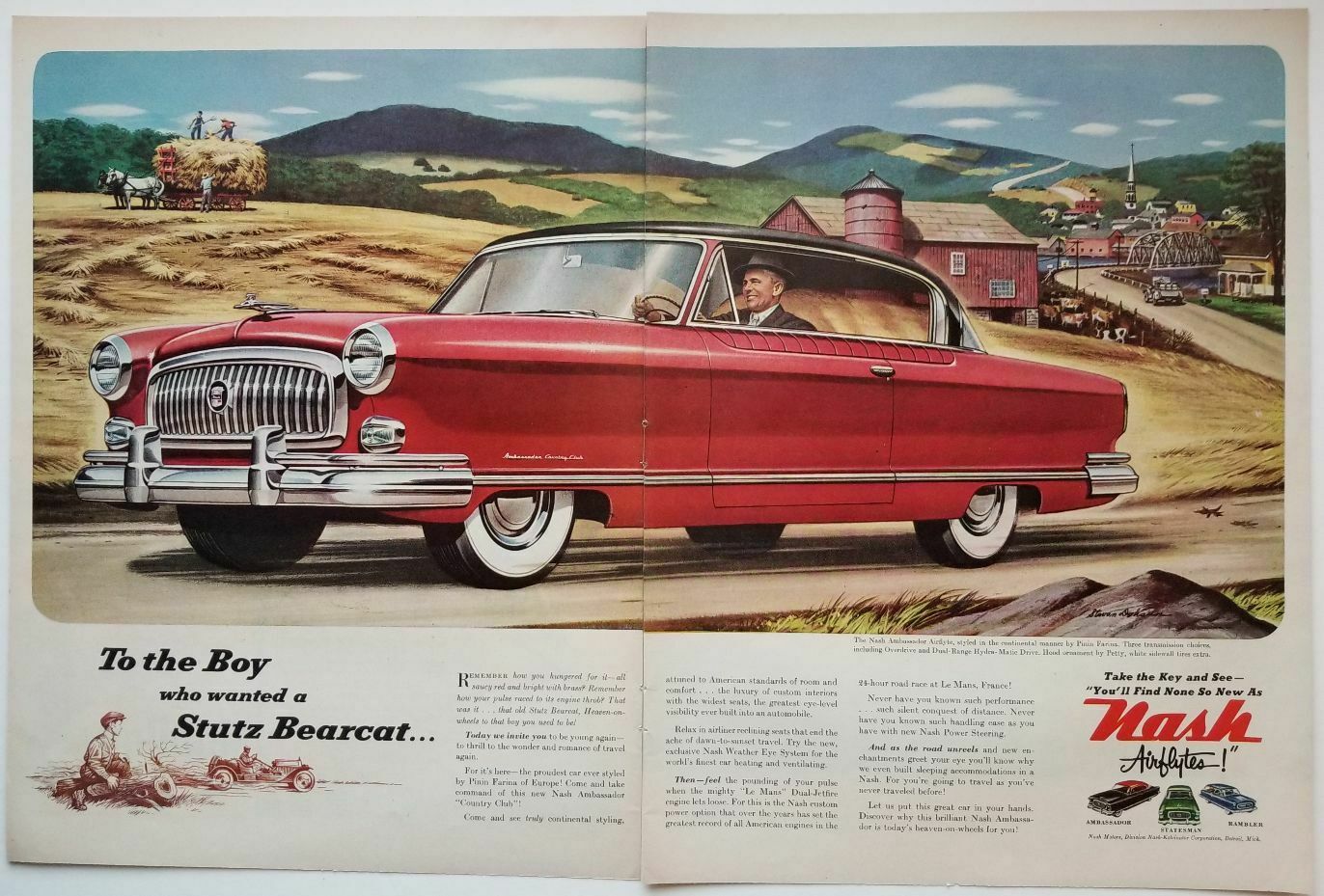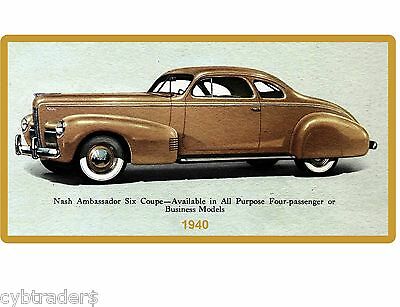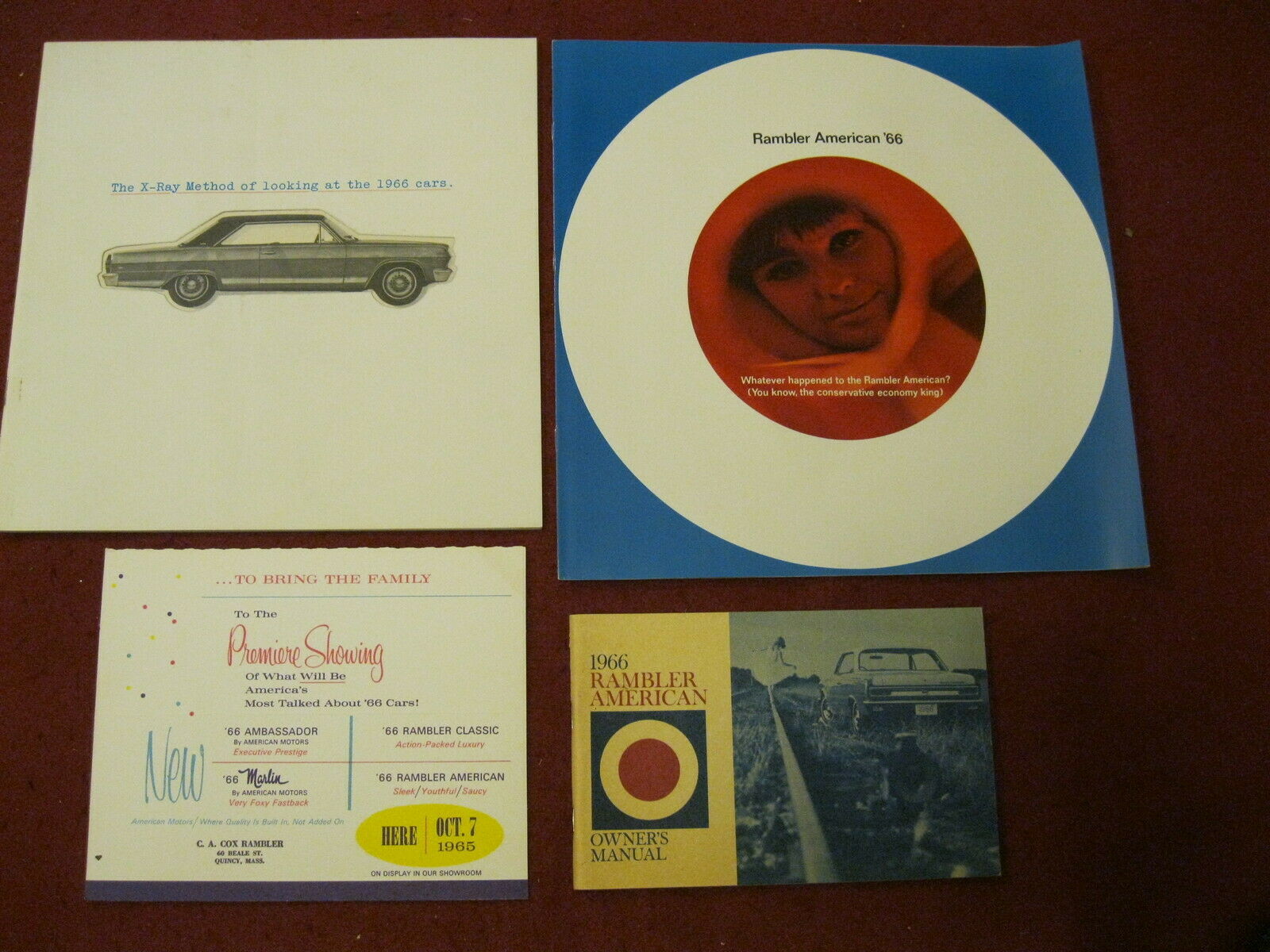-40%
Nash Ambassador 1953 2-Page Ad Stevan Dohanos and George Petty
$ 8.97
- Description
- Size Guide
Description
Wonderful, rare automobile advertisement. A two-page illustration of the beautiful 1953 NASH AMBASSADOR AIRFLYTE model.The illustration work was done by noted artist STEVAN DOHANOS.
This particular model was styled in the continental manner by Pinin Farina. This model also included a stunning hood ornament designed by GEORGE PETTY.
Ad is titled: TO THE BOY who wanted a STUTZ BEARCAT...
Ad copy reads:
Remember when you hungered for it -- all saucy red and bright with brass? Remember how your pulse raced to its engine throb? That was it...that old Stutz Bearcat. Heaven-on-wheels to that boy you used to be!
Today we invite you to be young again -- to thrill to the wonder and romance of travel again.
For it's here -- the proudest car ever styled by Pinin Farina of Europe! Come and take command of this new NASH AMBASSADOR "COUNTRY CLUB"!
Come and see truly continental styling attuned to American standards of room and comfort...the luxury of custom interiors with the widest seats, the greatest eye-level visibility ever built into an automobile.
Relax in airliner reclining seats that end the ache of dawn-to-sunset travel. Try the new, exclusive Nash Weather Eye System for the world's finest car heating and ventilating.
Then - feel the pounding of your pulse when the mighty "Le Mans" Dual-Jetfire engine lets loose. For this is the NASH custom power option that over the years has set the greatest record of all American engines in the 24-hour road race at Le Mans, France!
Never have you known such performance...such silent conquest of distance. Never have you known such handling ease as you have with new Nash Power Steering.
And as the road unreels and new enchantments greet your eye you'll know why we even built sleeping accommodations in a Nash. For you're going to travel as you've never traveled before!
Let us put this great car in your hands. Discover why this brilliant Nash Ambassador is today's heaven-on-wheels for you!
********************
********************
These ad pages are in very good overall condition. They have the normal minor wrinkles and bends from the pages being turned while bound inside the magazine. Pages were carefully removed from the damaged magazine issue, and the edges were trimmed. The paper has yellowed with age, and is somewhat brittle. Should be handled with care.
Pages each measure 10 1/8" x 13 3/8". Opposite sides include a full page ad for Frankfort Distillers Corp. and Mobilgas.
I'll place the pages inside a plastic sleeve and add a piece of white foam board for protection while mailing by USPS First Class in a bubble envelope.
I'll mail the same day, or next day after PayPal payment is received.
Following is some great information on both the illustrator of the ad, and the designer of the unique hood ornament. Two of these ornaments are currently listed on eBay starting at 95.00!
(1907 - 1994)
STEVAN DOHANOS
was an artist and illustrator of the social realism school, best known for his Saturday Evening Post covers, and responsible for several of the Don't Talk set of World War II propaganda posters. He named Grant Wood and Edward Hopper as the greatest influences on his painting.
Dohanos attended the Cleveland School of Art. He worked in fine art as well as in commercial art. He was a member of the National Society of Mural Painters and the Society of Illustrators. He was a founding faculty member of the Famous Artists School of Westport, Connecticut.
Along with J. C. Leyendecker and Norman Rockwell, Dohanos is best remembered as one of the Saturday Evening Post's most prolific and popular cover artists (over 125 covers) as well as much story work for the Post. He did murals for numerous Federal Buildings from West Virginia to the Virgin Islands; WWII posters; Postage stamp designs (served on Citizen's Advisory Committee for USPS); Christmas Seal art (he, himself, was afllicted with TB twice); Movie art (White Christmas). Other slick projects included Esquire, Medical Times (many covers). Ads for Nash Automobiles, Coca-Cola, Caterpillar, Four Roses Whiskey, Maxwell House, Pan Am, Cannon Towels, Olin Industries, John Hancock, etc.
His easel paintings and prints have been displayed in the Cleveland Museum of Art, Whitney Museum of American Art, Pennsylvania Academy of the Fine Arts, and Dartmouth College.
(1894 - 1975)
GEORGE BROWN PETTY IV
was an American pin-up artist. His art appeared primarily in Esquire and Fawcett Publications's True but was also in calendars marketed by Esquire, True and Ridgid Tool Company. Petty's Esquire gatefolds originated and popularized the magazine device of centerfold spreads. Reproductions of his work were widely rendered by military artists as nose art decorating warplanes during the Second World War, including the Memphis Belle, known as "Petty Girls".
Petty never discussed in detail those artists who influenced him, other than J. C. Leyendecker (an artist for The Saturday Evening Post during George's high school days) for his interpretation of men, Coles Phillips for his technique, and Maxfield Parrish for his use of light. However, it can be inferred from his later work that other influences included artists who were extremely popular in Paris at the time, such as Alfons Mucha, George Barbier and, in particular, the watercolor technique of England's William Russell Flint.
Petty is especially known for "the Petty Girl", a series of pin-up paintings of women done for Esquire from the autumn of 1933 until 1956. Petty frequently depicted these women with the relative lengths of their legs being longer—and the relative sizes of their heads being smaller—than those of his actual models.
So famous was the Petty Girl, MGM made a movie about her. With Esquire magazine's issue No. 1, Petty's girls were female shapes poured from a martini shaker of imagination. The lines were simple -- even non-existent -- shades of fade-aways by Coles Phillips, Valentine Sandberg and, most closely, Will Grefé. Petty girls were as healthy as milk, sexy as champagne and often posed in little more than ballet shoes. Having Petty's airbrushed beauties in an ad campaign was a plus (The Ice Capades, Rigid Tool Company, Old Gold Cigarettes, TWA). From magazine covers to Jantzen swimsuit ads to calendars, Petty was one of the best at depicting American women; he even created a hood ornaments for the Pinin Farina designed Nash Airflyte automobile. The 1945 Art Directors annual had illustrators' classifieds. Most artists listed their qualifications dryly: "Advertising illustrations," "Water color and oil," "Posters and Book Design," etc. Petty's ad was different. It said, "Telephones tenderly rendered.















